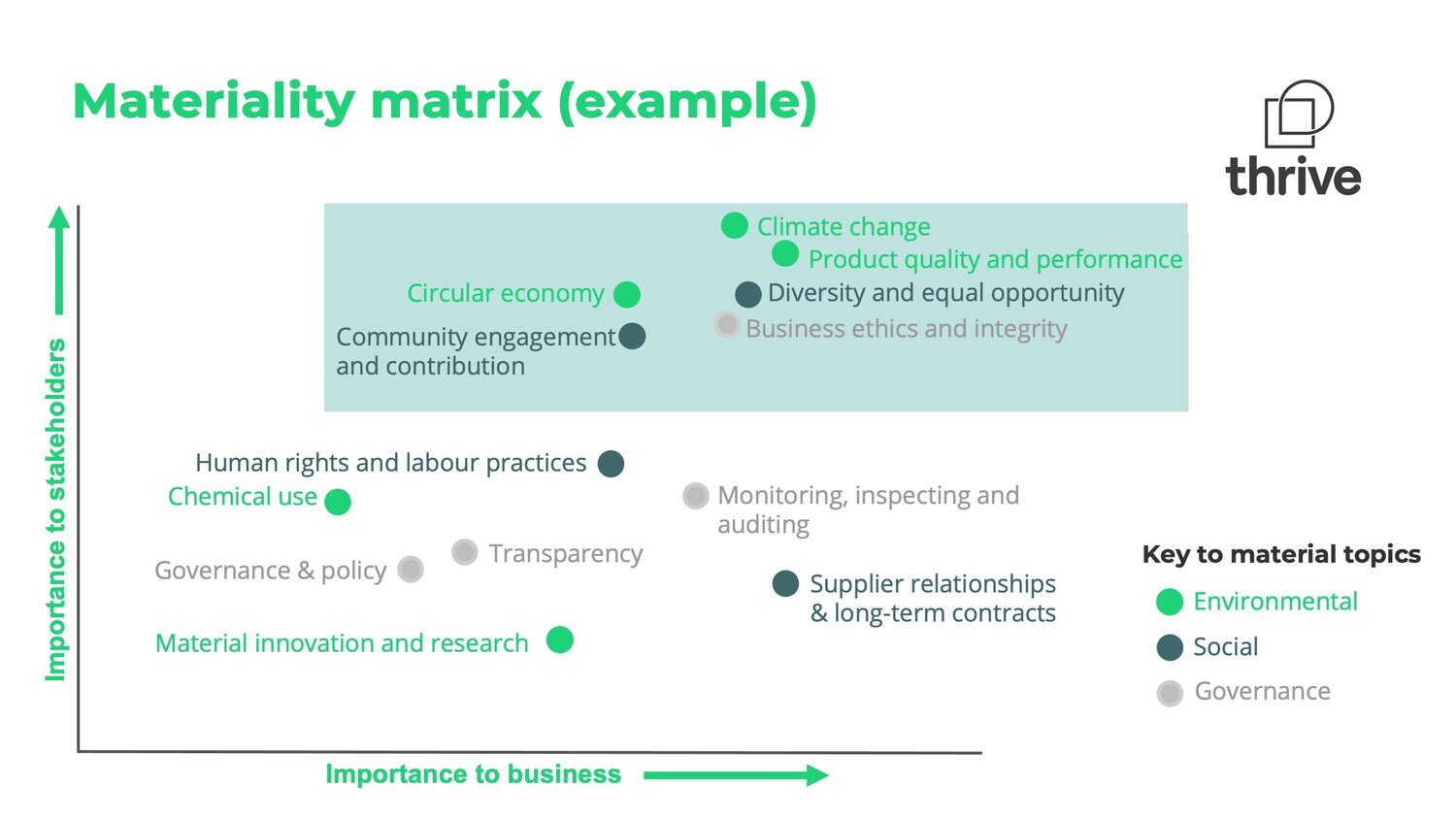Materiality Assessment: 5 ways this strategic tool delivers real commercial value
We needed a tool to help shape our longer term business strategies with broader sustainability impacts in mind; Thrive helped us achieve this, utilising an established but not yet widely used methodology (ESG), engaging a wide group of stakeholders and delivering a materiality matrix that gives us confidence that the strategies that we have now set are both commercial and sustainable.
— Mark Buckley, Finance Director, Rapha Racing Limited
Materiality Assessment is essential to any future looking, progressive business, yet it remains a relatively unrecognised and ambiguous concept.
We want to share 5 key benefits that a Materiality Assessment delivers and offer some Thrive perspective on which approach will drive maximum value for your business and your team.
1/ Reduced risk and maximised opportunity over the long term
The process of materiality assessment enables your company to systematically identify, assess and address the most critical non-financial risks and opportunities that face your business over the next 5-10 years. This means any factor which might have a present or future impact on your value drivers (think about supply chain and your indirect workforce) or your competitive position (reputation, consumer perception). Through engagement with both your business leadership team and your key stakeholder groups, from customers to investors, we investigate these challenges and issues across each of the ESG categories: Environmental, Social and Governance.
A Materiality Assessment is ultimately about informing value creation and risk mitigation by ensuring businesses focus on the issues that really matter to their stakeholders, the business and its investors.
2/ Strong credibility through transparency
The final output is a Materiality Matrix (see below) that visually plots and prioritises the ESG related issues most relevant to your business, however it is clear that the iterative process to get to this point adds significant value, as is repeatedly confirmed in feedback from clients. Being able to ‘tell the story’ of your materiality work in corporate communication gains stakeholder trust whilst open and authentic engagement builds confidence in the company’s commitment to address issues which could otherwise affect its value negatively.
Larger companies will review ‘materiality’ on an annual basis to ensure their areas of focus remain current as the business landscape evolves.
Whilst a less comprehensive assessment may be required, it is important that the company remains genuine in any engagement and does not see this as a ‘tick-box’ exercise to satisfy a reporting requirement. In our experience, this becomes highly evident in the subsequent communications and can undermine the desired value.
Transparency and authenticity are key to ensure your materiality work plays its part in achieving a strong ESG rating for your business.
3/ Competitive edge
Meaningful engagement with your leadership team and other key stakeholder groups including your customers, supply chain and staff results in high value intelligence relating to each group.
The final Materiality Matrix combines the stakeholder feedback and maps it against the understood business priorities for a clear view of the overall priority areas for the business.
A recent materiality assessment we led with Rapha, a global sportswear and lifestyle brand included a survey to approximately 50,000 customers worldwide. Within the analysis of results, we mapped the results geographically to gain insight into their top ESG related priorities as well as overall level of customer engagement by retail region, informing future sales strategy.
There is, however, a wealth of intelligence to be mined from the assessment results from each stakeholder group, providing granular insight into what each one believes is most important for your company to focus on and address, crucially offering you the opportunity to anticipate and address emerging market needs and direction.
4/ Stakeholder confidence
At first a Materiality Assessment can feel like quite a bold step for some companies to take but believe us, even reaching out to stakeholders sends a very positive message, building their confidence in your brand.
It shows commitment to their future needs as it invites stakeholders to give an honest, anonymous view on the priorities they believe are most material to your business, with an expectation that this feedback will be integrated into future strategy.
It is widely reported that the investment community recognises regular materiality review as a key building block to risk mitigation and future resilience, both of which are reflected in a strong ESG rating which can increase valuation.
Integrating the results of your Materiality Assessment throughout your corporate strategy (not just as a bolt-on ESG agenda) will significantly strengthen resilience for long term value creation.
5/ Market leadership
A less reported but high value outcome that we see during the Materiality Assessment process is an increased level of energy, engagement and enthusiasm for the ESG agenda across senior management. Following the Materiality Assessment they are equipped and empowered to decide which issues are most business critical in terms of reputational, operational and financial risk across all functions. Time spent with these decision makers to provide context to their responsibility often catalyses further discussion amongst them and prompts wider strategy review as they align and recognise that driving the ESG agenda is their collective responsibility, not just that of the sustainability team.
The priority areas highlighted within the Materiality Matrix provide high-value intelligence for business and communication strategies as well as a vital cornerstone for ESG strategy, target setting and reporting.
Used to its full potential, a Materiality Assessment helps align internal teams, gain senior buy-in and spark valuable engagement with external stakeholders such as consumers and supply chain. The evidence gathered informs and guides focussed sustainability strategy, targets and reporting.
Thrive helps companies realise commercial value from sustainability. If you would like to know more about how a Materiality Assessment would work for your your business, please contact: jane@thethrivebusiness.com



